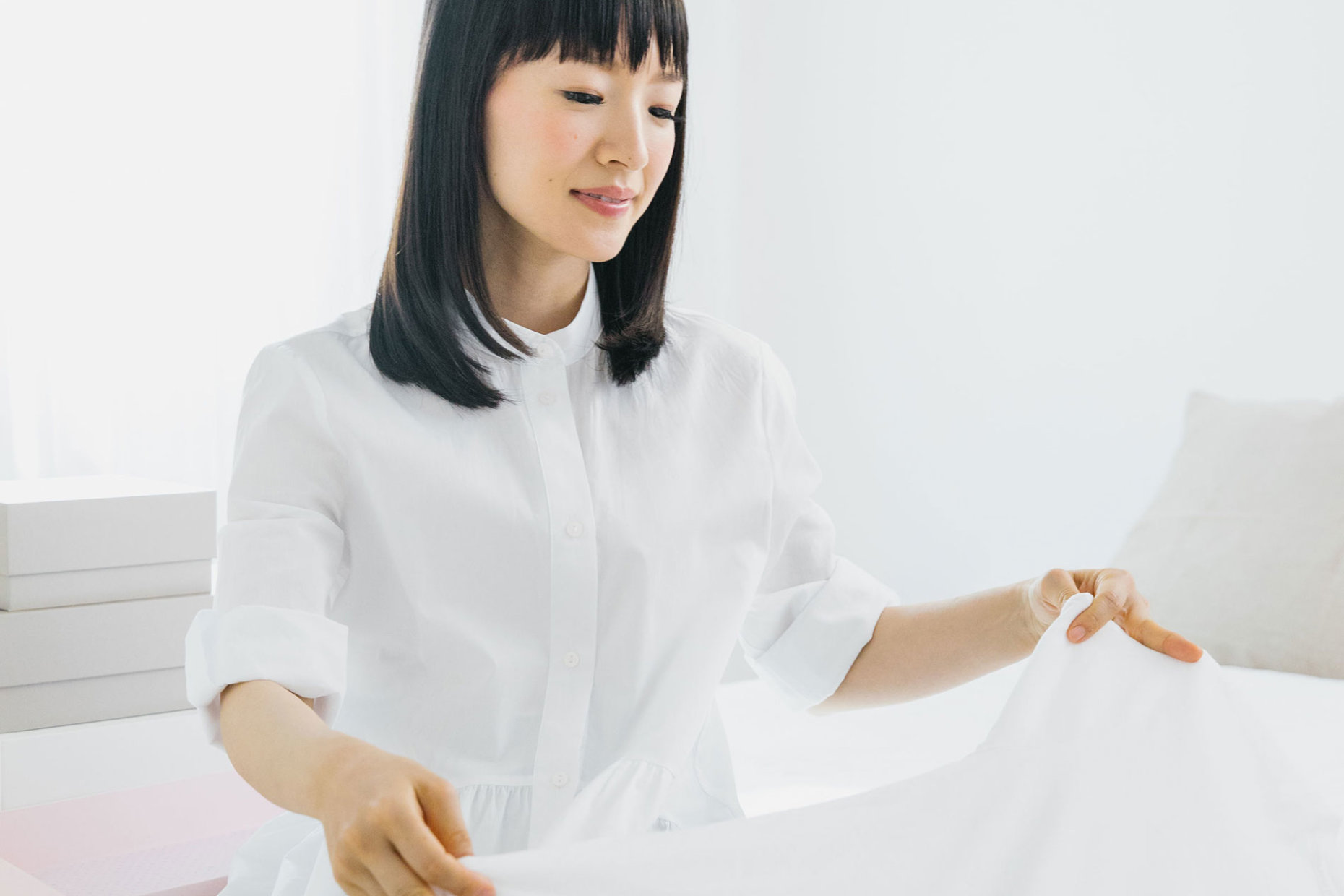Marie Kondo’s method for folding clothes fundamentally changes not only the way you organize your closet and dresser drawers but also the way you get dressed. Wearing clothes that spark joy changes the way you feel — and how you walk into the world.
The beauty of The KonMari Method™ approach to folding clothes is that it applies to almost every type of clothing and textile, from folding shirts, shorts and socks to folding bathroom linens or duvet covers. Still, certain questions often arise when Marie works with clients. We’re answering a few of the most common questions about the KonMari fold here, so you can easily use Marie’s method in every bedroom dresser and linen closet.
Tidy Tip: If you haven’t already, start by reading our guide to folding clothes with tutorial videos from Marie herself.
Questions in this guide to folding Marie Kondo’s way:
- Doesn’t it take longer to file fold clothes rather than stack them?
- How do I decide which clothes to fold and which to hang? Should I hang or fold t-shirts?
- How do I keep the clothes standing upright in a drawer? Won’t they fall over?
- Should I organize my clothing drawers in any particular way?
- How can I tell which shirt is which if I wear mostly the same colors?
- How do I fold socks and underwear the KonMari way? (And do I really need to?)
- What’s the best way to fold leggings?
- What about children’s clothes? And plus-size clothes?
- Is there a KonMari way to fold a fitted sheet?
- How does Marie recommend folding bath towels, kitchen towels and other linens?
Doesn’t it take longer to file fold clothes rather than stack them?
Like most new skills, it takes time to learn the KonMari Method for folding clothes. To master it more quickly, why not immerse yourself in the process by committing to a one-time tidying festival?
The KonMari Method invites you to pull everything out of your closet to determine what sparks joy. You’ll then fold and organize all the clothes you choose to keep. By the end of your tidying festival, you’ll be able to file fold clothing with your eyes closed! For more about the KonMari Method, read our six rules of tidying or, for visual lessons, join our online Fundamentals of Tidying course!
How do I decide which clothes to fold and which to hang? Should I hang or fold t-shirts?
T-shirts should always be folded. As a general rule of thumb: Marie recommends folding everything you can because it saves space. Of course, some clothes prefer hanging. “Hang any clothes that look like they would be happier hung up, such as those made of soft materials or highly tailored cuts,” Marie says, “These we should hang willingly.” This list includes blouses made of lightweight materials, such as viscose or silk, dry-clean only trousers or delicate dresses.
How do I keep the clothes standing upright? Won’t they fall over?
Using Marie Kondo’s method for folding clothing creates compact, tidy squares that stand upright on their own. Try placing them in rows in your drawer — it might surprise you how sturdy those file-folded clothing items are!
The other trick is to fill your drawers without overfilling or underfilling them. In both “Spark Joy: An Illustrated Master Class on the Art of Organizing and Tidying Up” and our Digital Tidying Course, Marie recommends what she calls “the 90 percent technique.”
“The rule of thumb for storage is 90 percent,” Marie writes in “Spark Joy.” “Once you’ve chosen the things you love, the correct approach is to fill your drawers to the point where they look full but not stuffed.”
Marie goes on to explain that if you have items that fill more than 90 percent of your available storage space, it’ll be hard to pull the items out or the storage will begin overflow; if you have less — for example 70 percent, in anticipation of accumulating more things — you will then start to collect items you don’t need (and that don’t spark joy) to fill the space.
Should I divide the inside of my drawers in any particular way?
While it depends on the size of your drawers and your clothing items, Marie often recommends using drawer organizers to divide larger spaces that contain multiple clothing types. You can use storage solutions designed specifically for that purpose, such as hikadashi boxes or adjustable drawer dividers. Regardless of what you use, organizing similar types of clothing together will make it easier to find what you need.
How can I tell which shirt is which if I wear the same color often?
We hear this question often from people who wear mostly black or only neutrals. Once you’ve dramatically reduced your closet to include only the clothing that sparks joy, you’ll find it’s very easy to recognize the items you have even when they’re file folded. Often, the same “color” isn’t the same at all when you place two items next to each other!
If all else fails, run your hands over each row. You’ll quickly find the familiar texture of the shirt you’re after, and it’s also a nice opportunity to quietly express gratitude for the items you love!
How do I fold socks and underwear the KonMari way? And do I really need to?
You’ve likely heard something about Marie’s opinion on folding socks — it caused quite the stir with the publication of “The Life-Changing Magic of Tidying Up.” Marie believes that rolling socks into balls, as many of us do, does not allow the socks to rest. Folding them shows respect for how much they support you — they literally help you walk through the world — while also preventing them from stretching out over time.
Here is how Marie Kondo folds socks:
- If you’ve rolled or folded them together by inversing the top of the socks, start by unfolding them
- Place one sock on top of the other
- Follow the same principles for folding other clothing (Follow our folding guide here)
How about leggings?
Generally, you can treat leggings the same way Marie recommends folding stockings, depending on thickness. To fold leggings:
- If you’ve rolled or tied them, start by untying them. Give them room to breathe and rest!
- Fold them in half lengthwise
- Then fold either into half or thirds, making sure the waist protrudes slightly. For thicker leggings, folding into half might be easier. The goal is to create a stable roll when finished, which Marie often compares to a sushi roll
- If the thickness of your leggings makes them feel more like a pair of pants, you may want to follow Marie’s method for folding pants instead
What about children’s clothes or plus-size clothes?
Typically speaking, you can use the same KonMari folding techniques for all sizes of clothing, including children’s clothes except that their smaller clothes require fewer folds. As a general rule, fold shirts and shoes in half rather than three. Otherwise, the method remains the same! For this reason, Marie loves teaching kids how to tidy early — it helps them make organizing and folding part of their routines!
For most plus-size clothes, you can follow Marie’s standard rules for folding, but we’ve also written a guide to KonMari folding plus-size clothes with some added suggestions.
Is there a KonMari way to fold a fitted sheet? What about other linens and towels?
The bane of every tidier’s existence: the fitted sheet. The good news is that Marie’s folding method works here, too — and for all other awkward or bulky bedroom and bathroom linens!
Here’s the trick: Once you get any items, including fitted sheets, into a rectangular shape, the same KonMari folding methods apply.
We’ve dedicated an entire lesson in our Digital Tidying Course (Lesson 8) on how to fold the most difficult linens, like towels, comforters, and sheets. There’s also a handy video tutorial for how to fold a fitted sheet, courtesy of Marie’s Netflix series, available on YouTube.
What about bath towels, kitchen towels, and other linens?
The only difference for towels and linen, compared to clothing, is that bath towels and linens can be folded and rolled then stacked — yes, stacked! Usually, towels are taken from the top of the pile, so you generally won’t look for a specific towel from the middle. As for kitchen towels and fabric napkins, consider giving them a drawer in your kitchen where you can fold, roll, and stand them upright, just as you would do with t-shirts in a dresser drawer. (Apartment Therapy once called Marie’s kitchen towel method, “the only way to store kitchen towels.”)
As with most aspects of The KonMari Method, when in doubt, follow your instincts. As you tidy your home and organize your closets, you will likely encounter some unexpected items that require some type of file folding. Once you’ve mastered the basics of folding clothing, you’ll be able to apply the same general rules to those outliers.
The results of folding the KonMari way will astound you. Imagine opening your drawers every day to see only clothing that sparks joy!








